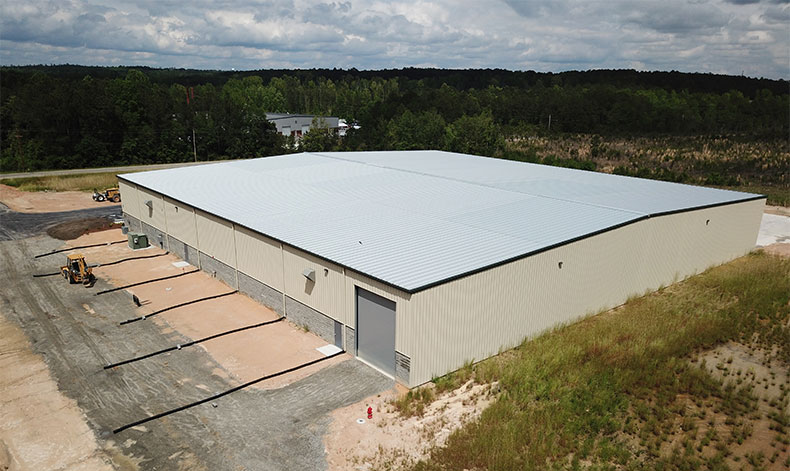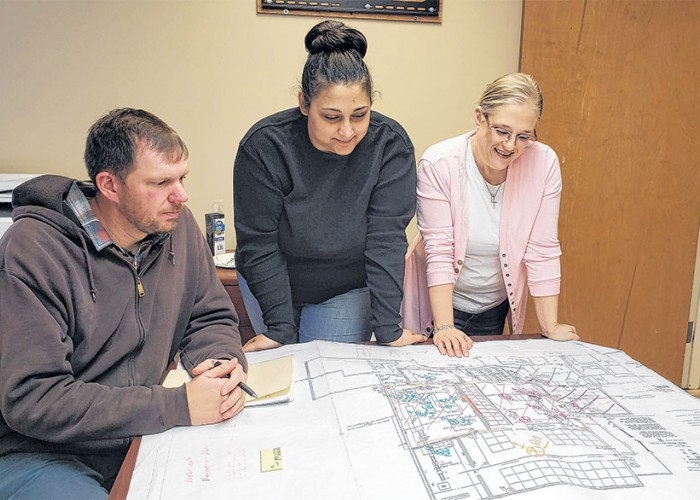Electric Co-ops are Paving Pathways to Progress
NC electric co-ops are working with local communities to foster economic growth
By Scott GatesHatteras Village, nestled on the southern tip of Hatteras Island in the Outer Banks, has a lot to offer. Access between Pamlico Sound and the deep waters off the continental shelf make it ideal for charter and commercial fishing. Its pristine beaches are great for shelling. And the black-and-white striped Cape Hatteras Lighthouse is the tallest brick lighthouse in the country.
But there’s one thing the community has been lacking: a safe, dedicated means for pedestrians and bicyclists to travel around town.

Hatteras Village recently completed a village pathway, providing a safe means for pedestrians and bicyclists to travel around town. The pathway was funded in part by Cape Hatteras Electric Cooperative .
Photo by Daniel Pullen Photography.
“In all of our community meetings over the last 15 years, Hatteras Village sidewalks have been the top priority for everybody in this community,” says Dennis Robinson, Hatteras Village Community Center District chairperson. “They’ve always wanted safety for their children, they’ve wanted people to come to their business safely and leave safely.”
Funding the project had been a significant hurdle, but between local partnerships — including funding from Cape Hatteras Electric Cooperative (CHEC) — and legislation to free up local tax dollars, the project was completed this past summer.
“Hatteras Village finally has its pathway,” Robinson says. “Cape Hatteras Electric Cooperative was an invaluable partner in making that happen.”
The project is one example of how electric cooperatives are finding new and creative ways to support communities and economic development in parts of North Carolina where resources may otherwise be stretched thin.
“Driving economic growth and job creation is one way our cooperative network is building a brighter future for rural people and communities,” says Ryan Nance, director of economic development for North Carolina’s Electric Cooperatives. “The affordable, reliable electric service provided by electric cooperatives is a draw for new and growing companies in our communities. But we’re asking ourselves: What else can electric co-ops do to help the counties we serve attract and retain businesses?”
The answer will depend on the need of each unique community, Nance explains, although electric co-ops have been pursuing new economic development projects in two main areas: “site readiness” projects (preparing move-in ready spaces for new business), and community development projects like the Hatteras Village pathway.
Move-in ready sites
In general, the concept of a site readiness program has evolved over the past two decades, and electric cooperatives in North Carolina have made it a priority in recent years. When considering North Carolina, businesses that take a pass list a lack of suitable buildings or sites as the No. 1 reason for looking elsewhere, according to the North Carolina Economic Development Association (NCEDA), which promotes the state for business investment. Nance serves on its board of directors.
Last January, outgoing NC Commerce Secretary Tony Copeland spelled out the issue of site readiness in no uncertain terms to the NCEDA board.
“If I am to leave one call-to-action for this board, it is that our state needs more ready sites and buildings to compete,” Sec. Copeland said at the time.
Martie Butler, economic developer for Richmond County, spotted this need in her community shortly after accepting the position in 2013. Though led by business-savvy local officials, and despite it being geographically well-positioned and having ample infrastructure, Richmond County lacked high quality, ready-to-go industrial buildings.
Wadesboro-based Pee Dee Electric, which serves portions of Richmond County, stepped up to help meet that need.
In the past decade, the co-op has worked with Richmond County Government to construct five new shell buildings. Recruitment and expansion announcements followed, which have driven employment growth, economic investment and new tax revenues. The collaboration has added $75 million to Richmond County’s tax books and brought more than 200 new jobs to the region.
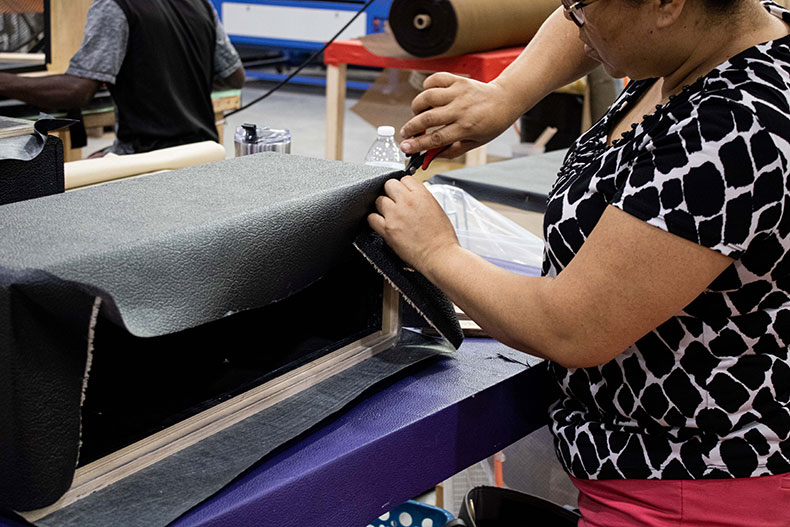
New businesses in Four County EMC’s service area include Mojotone, a vintage guitar and amplifier manufacturer. Here, an employee assembles an amplifier.
“Our joint efforts have resulted in three new companies locating to Richmond County and two existing industries expanding their footprints here,” Butler says. “This would not have been possible without the great partnership we have with Pee Dee Electric and the cooperatives’ economic development resources.”
Funding growth
Pee Dee Electric provided funds for those site development projects through a U.S. Department of Agriculture resource called the Rural Economic Development Loan & Grant (REDLG) program. The REDLG program provides rural utilities with grants and zero-interest loans to directly fund local projects that create and retain employment in the communities they serve.
North Carolina’s electric cooperatives are national leaders in utilizing REDLG funds. Twenty-one NC co-ops have tapped the program to channel a total of $70 million to projects across the state, supporting the creation of more than 5,000 jobs.
Four County EMC is another NC leader utilizing REDLG funds and participating in local site readiness projects. The Burgaw-based electric co-op has worked extensively with local governments and economic development organizations to create additional, available property for industrial development in Bladen, Columbus, Duplin, Pender and Sampson counties. Development has included coordinating land acquisition and securing funds for, and facilitating, infrastructure development.
“Over the past nine years, Four County EMC has experienced phenomenal growth with business and industry, with $753.57 million in new investments and more than 810 new jobs,” says Four County EMC Director of Economic & Community Development Jimmy Smith. “Over 20 years, 10 new industrial buildings have been built and occupied by companies.”
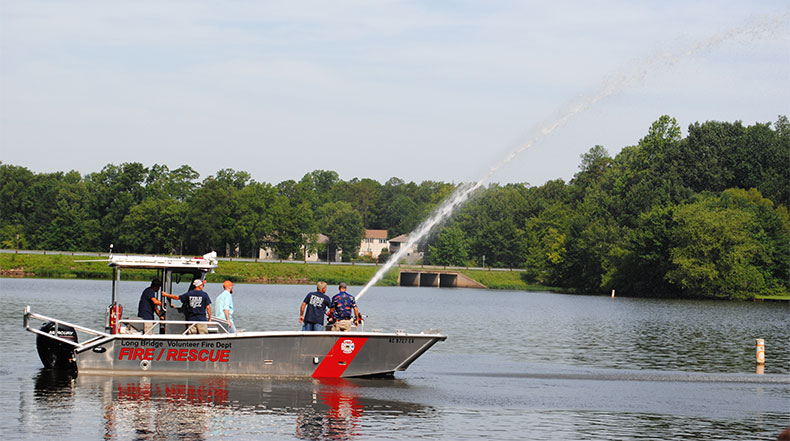
Halifax EMC, based in Enfield, provided a REDLG loan to enable the purchase of a fire and rescue boat for Lake Gaston.
New businesses in Four County EMC’s service area include Sue Bee Honey, a honey processing plant; Del-Ton, a rifle manufacturer; Mojotone, a vintage guitar and amplifier manufacturer; and Cardinal Foods, a processing, marketing, and distribution company for fruits and vegetables. An ongoing expansion of Cardinal Foods will create about 50 new jobs and make the company one of the world’s largest sweet potato fry manufacturers.
“The announcement of the Cardinal Foods expansion encompassed many meetings of Wilmington Business Development behind the scenes to bring this project to fruition,” Smith says.
“Site development is all about building public-private partnerships and leveraging the strengths of our communities,” Nance says. “If we’re doing the best we can at this, we’re going to attract more private investment and jobs to our communities — we’re going to be successful.”
Commitment to community
Site readiness projects are making a big impact on employment and investment in communities, but electric co-ops are also leveraging millions in REDLG funds to improve quality of life in other ways. Community development projects include investments in local emergency medical services, health clinics, hospitals, libraries, schools and volunteer fire departments, to name a few.
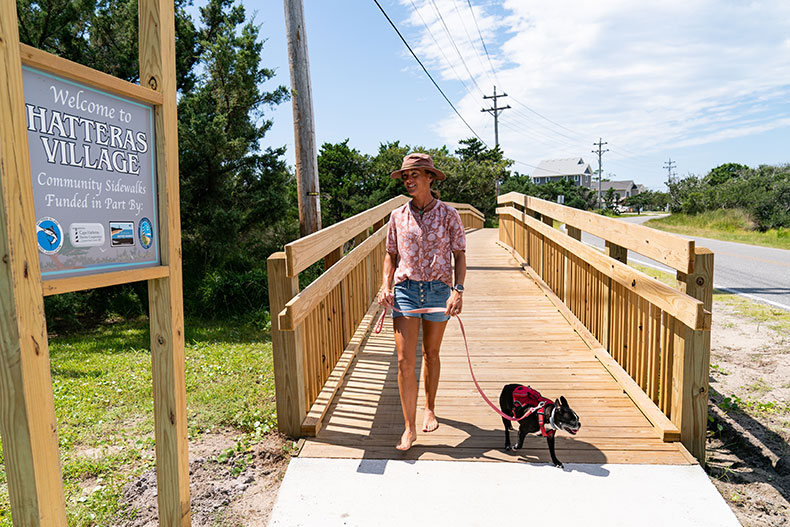
Kate Pullen and her dog Walter try out the new Hatteras Village pathway. The pathway is one example of how electric cooperatives are finding new and creative ways to support communities and economic development in parts of North Carolina where resources may otherwise be stretched thin.
Photo by Daniel Pullen Photography
Halifax EMC, based in Enfield, provided one such REDLG loan to enable the purchase of a fire and rescue boat for Lake Gaston. Long Bridge Volunteer Fire Department received a 10-year, $150,000 zero-interest loan to purchase the boat, which is the lake’s first of that caliber.
The USDA loan secured by Halifax EMC establishes an ongoing resource to be utilized within Halifax and Warren counties. As the funds are repaid, they will be available for re-loan to assist with future projects in communities served by the co-op.
The loan structure is similar to what CHEC used to fund the Hatteras Village pathway. The co-op’s board of directors voted to provide the funding for an environmental assessment to help kickstart the project, but the bulk of funding came through a $360,000 zero-interest REDLG loan. The loan funded more than a third of the construction project.
“This pathway is a major asset for Hatteras Village, connecting pedestrians to marinas, art galleries, gift shops, and local staples like Village Red & White, Lee Robinson General Store and Sticky Bottom Produce,” says CHEC Director of Public Relations & Marketing Laura Ertle. “We saw the pathway as an opportunity to improve the safety of our local community and support these local businesses — all part of a guiding principle important to all electric co-ops: Commitment to Community.”
-
Co-ops support their communities
-
Share this story:

